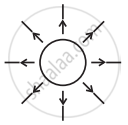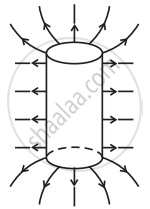Advertisements
Advertisements
प्रश्न
Sketch the electric field lines for a uniformly charged hollow cylinder shown in figure.

उत्तर
No, the field may be normal. However, the converse is true.

Top view

Side view
APPEARS IN
संबंधित प्रश्न
Obtain the formula for the electric field due to a long thin wire of uniform linear charge density λ without using Gauss’s law. [Hint: Use Coulomb’s law directly and evaluate the necessary integral.]
Electric intensity outside a charged cylinder having the charge per unit length 'λ' at a distance from its axis is ________.
(a) E = `(2pi in_0 lambda)/(Kr^2)`
(b) E = `(in_0 lambda)/(2piKr^2)`
(c) E = `lambda/(2piin_0Kr)`
(d) E = `(4piin_0lambda)/(Kr^2)`
Draw a graph to show the variation of E with perpendicular distance r from the line of charge.
A closed surface in vacuum encloses charges –q and +3q. The total electric flux emerging out of the surface is :
Which statement is true for Gauss law -
A spherical ball contracts in volume by 0.02% when subjected to a pressure of 100 atmosphere. Assuming one atmosphere = 105 Nm−2, the bulk modulus of the material of the ball is:
If the ratio of radii of two wires of same material is 3 : 1 and ratio of their lengths is 5 : 1, then the ratio of the normal forces that will produce the same extension in the length of two wires is:
What is the nature of the Gaussian surface involved in the Gauss law of electrostatics?
A solid metal sphere of radius R having charge q is enclosed inside the concentric spherical shell of inner radius a and outer radius b as shown in the figure. The approximate variation of the electric field `vecE` as a function of distance r from centre O is given by ______.

Draw a graph of kinetic energy as a function of linear charge density λ.
